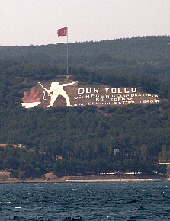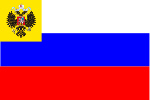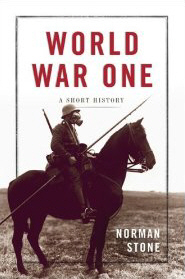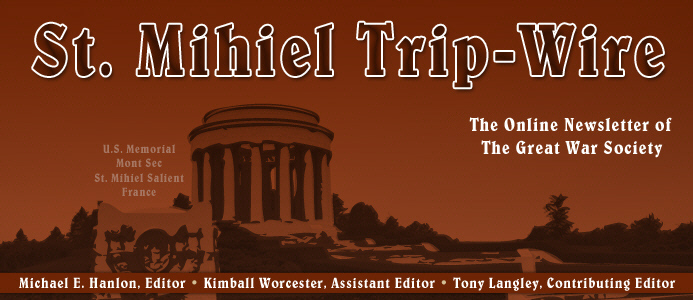

Seventh Anniversary Issue
TRENCH REPORT: We're back just in time from our travels to Kansas City and Turkey to celebrate our seventh year producing the St. Mihiel Trip-Wire. A little pat on the back to my assistant editors Kimball and Tony, and a big thank you to you readers and contributors, who have provided support and interesting material to us over the years. As I was putting this issue together there was one large presence who kept battling his way into almost every feature in this issue. That party is myself. You are going to read about my most recent trip to the Gallipoli battlefields, a meeting I held in Istanbul, an event I hosted in Kansas City, and more about my publishing and plus a lot on plans for travel to the battlefields. Longtime readers of the Trip-Wire know that I've never viewed this publication as a personal "Blog". I generally just place material that's timely and ready to go, which occasionally includes my pieces or opinions, but it turns out that this month a lot of what is to be presented has my name attached. I promise to avoid making this a practice. . .I want to congratulate both the WFA-USA and The Great War Society (especially my friend WFA-USA President Doran Cart, who planned and hosted things) for presenting an outstanding seminar at a superb venue, The National World War I Museum, in September. As a matter of fact, it was such a success that we are all going back next year in September to do it again with a new program. MH
This Month's Internet Feature
The Gallipoli Battlefields
Overview of the Gallipoli Campaign
The Victory of March 18: Dardanelles Naval Campaign (Excellent Turkish Site)
Australian Broadcasting Company's 3-D Gallipoli Site
How Gallipoli Looked from Offshore
"Why the Allies Failed" by Tim Travers
Mapping Gallipoli
 Oscar Gronau (arrow) and his mates relaxing on the Eastern Front in August 1914. Most of the men were killed in the early actions. Oscar lived, came to America in 1926 and prospered. (Life Magazine Archives)
New at Our Own & Our Friends' Great War Websites
Click on Title or Icon to Access
|
Recommended by regular contributor Len Shurtleff:
American Aviators in World War I presented by Narayan Sengupta
Nicely done site on the American Air Service and the pilots.
At Great War Society Sites
In honor of Armistice-Remembrance-Veterans Day, visit our huge photo album
Need help with your research? Want to contribute an article? Want you book reviewed? Make an announcement or post and advertisement about a WWI-related event or product? Visit:
At the WFA-USA
|

Founder of 20th Century Fascism, Benito Mussolini, served in the front lines in the Great War. He was assigned to the 11th Bersaglieri Regiment and fought in the Battles of the Isonzo. He was wounded (some sources say in an accident) and discharged before the war's end. The "Black Shirts", his earliest enthusiasts were predominately fellow veterans.
|
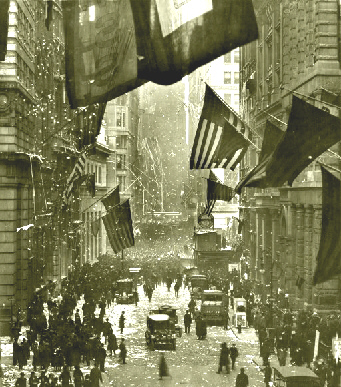
Wall Street, Armistice Day,
November 11, 1918
from the Smithsonian Collection
|
GREAT WAR 2009 EVENT CALENDAR
|
Honoring the AEF & the Doughboy Generation
The Great War Society's Annual
Armistice-Remembrance-Veterans Day
November 14, 2009
Francesco's Restaurant, Villa Room
Oakland, California
Downloadble pdf document with details: (link)
|
Western Front Association
U.S. Branch Chapter Meetings
Check for Your Region
Regularly Updated (details)
|
Great War Society Monthly Chapter Meetings
Berkeley, San Francisco, and Palo Alto, CA
Regularly Updated (details)
|
Upcoming Events at the National World War I Museum
Kansas City, Missouri
Regularly Updated (details)
|
Send additions/corrections:
Email Response
|
Screen Australia today announced it would back a $5.7m (A$8m) war movie Beneath Hill 60, the only feature to secure the federal government agency's backing this month. The fully Australian production, which is set on the Western Front in Belgium during World War I but will be entirely filmed in Townsville in Queensland, goes into production from July 20. (film Blog)
The docudrama Paris 1919, based on Margaret Macmillan's acclaimed work, is now available as a DVD in the U.S. and Canada. (order)
On September 25, 2008, Senator Claire McCaskill of Missouri introduced a bill to rename the Liberty Memorial at Kansas City, site of the National World War I Museum, the "National World War I Memorial." (press release)
Commemorations:
On October 10, 2009, members of the Royal Tank Regiment helped dedicate a new tank memorial at Poelcapelle, north of Ypres. Passchendaele was an important part of the learning curve for tanks. Lessons learned there were applied at the Battle of Cambrai later in the year:
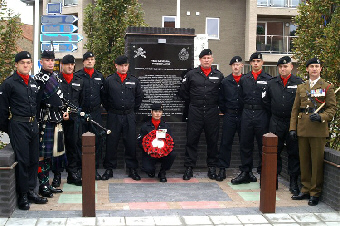
Max Cleland, newly appointed Secretary of the American Battle Monuments Commission, pays his respects to Commission founder, General of the Armies John J. Pershing, at Arlington National Cemetery. The occasion was the 139th anniversary of Pershing's birth, September 13, 1860.
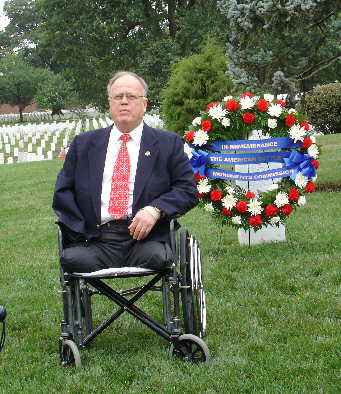

Stop passerby!
The ground you tread on, unawares, once witnessed the end of a generation.
Listen, in this quiet earth beats the heart of a nation.
Turkish Monument, Above the Ferry Terminal at the Gallipoli Peninsula
|
Position at 11 a.m. 11 November 1918
Meuse-Argonne, Verdun & St. Mihiel Sectors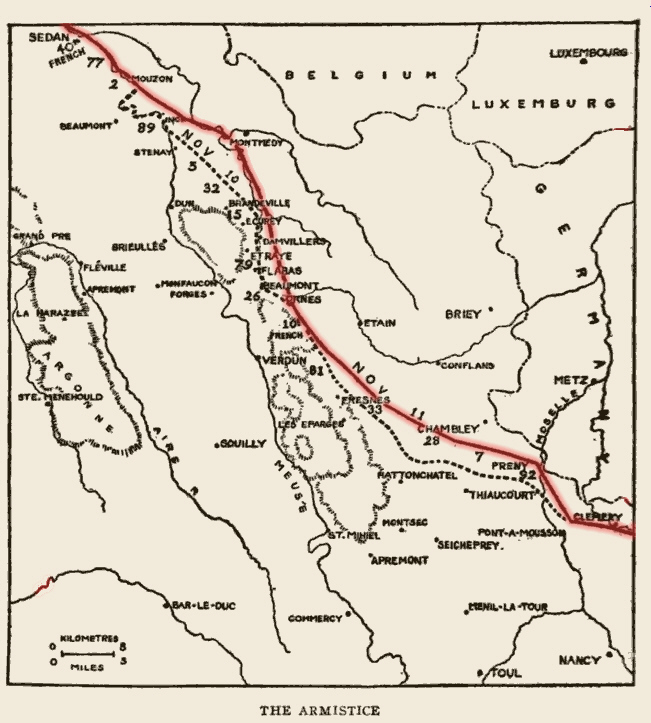
|
|
|
Page Two
|
|
|
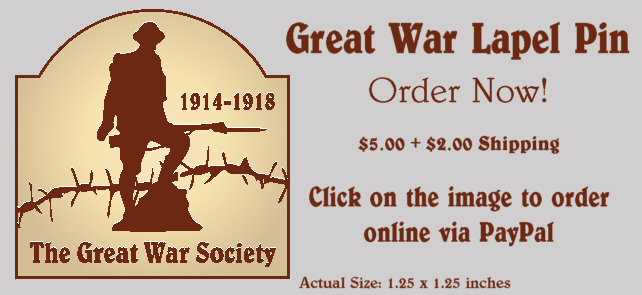 |
In September I led my first tour of the Gallipoli Battlefields. It was with a small group, but it turned out to be a wonderful success. My parent company Valor Tours of California found an outstanding local company, named Flo-Turkey, to handle our local arrangement. Valor Tours wants to run the same program next September, but needs eight passengers to make it viable. Email me if you are interested in more information about our 2010 Gallipoli Tour (email)
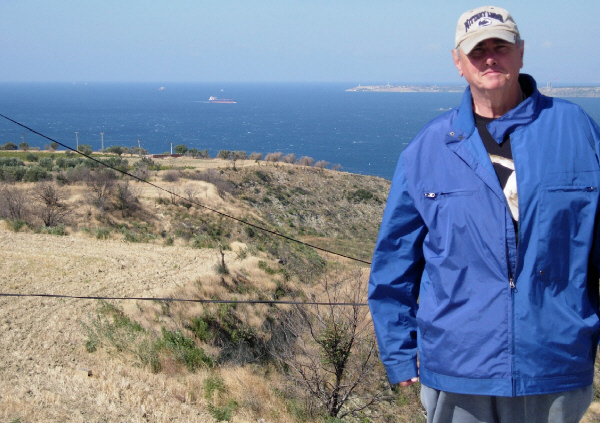
Your Editor at the entrance to the Dardanelles, 27 September 2009. I'm Standing on the Asian Side, not far from the ruins of Troy. In the distance is Cape Helles.
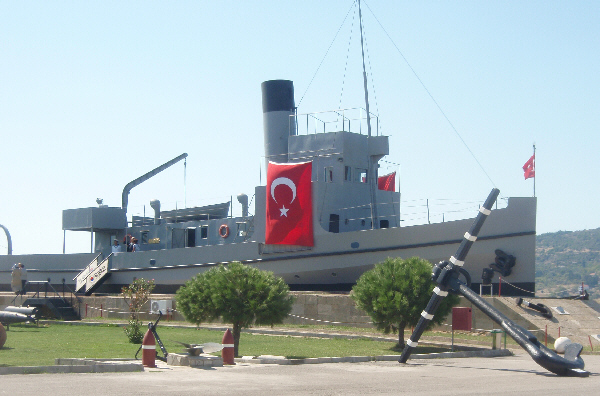
Full-sized replica of the most celebrated ship in Turkish history, The minelayer Nusret, at the Naval Museum, Çanakkale. This ship laid the string of mines that sank three battleships on March 18, 1915. The Turkish perspective is that the defeat of the Allied naval assault doomed the entire invasion, and the subsequent land campaign never had a chance of succeeding.
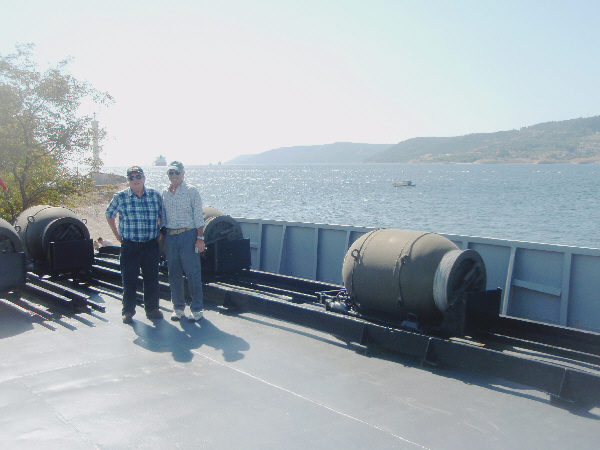
Two of the tour members, David and Mike, at the Naval Museum, which is located at the Dardanelles "Narrows". These are the types of mines that sank the battleships. The ships went down immediately behind the guys.

V Beach: the best known of the five landing sites at Cape Helles on April 25, 1915 viewed from a Turkish defensive post. The exit floats of the ill-fated SS River Clyde and the few men who made it ashore were subject to withering enfilade fire from this position all day long.
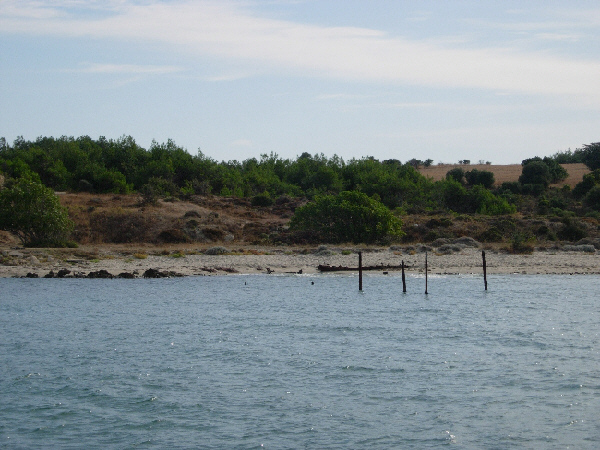
W Beach: Our Boat is is just behind the remains of one of the piers built to supply the troops at Helles after the initial landing. This site is also known as "Lancashire Landing" in honor of the six VCs awarded for service "before breakfast" by members of the Lancashire Fusiliers.
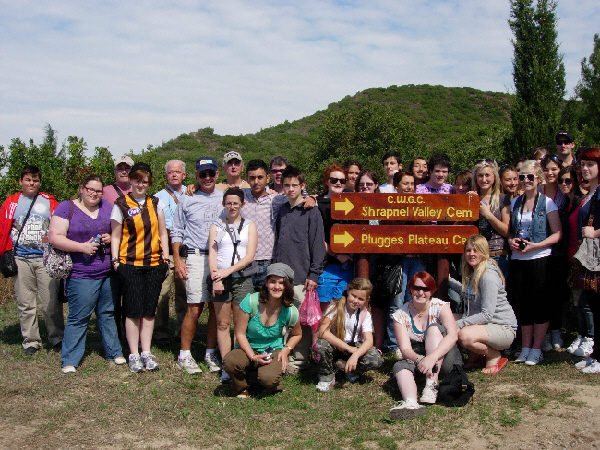
At Anzac we met a group of students and their teachers from Sydney. They had also visited the Western Front. The signs are quite evocative. Plugge's Plateau (behind the group) was the site of one of the first struggles of the campaign and Shrapnel Valley would be the essential communications and rogistical route for the Anzac Front.
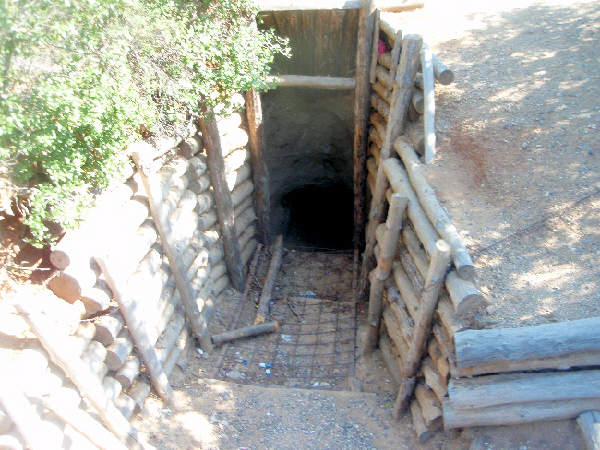
On the high ridge between Lone Pine and the high peaks of Sari Bair the front line at Anzac stabilized, and things around there Have a "Western Front" Look. This is an Australian Trench and Tunnel Entrance before Johnston's Jolly.
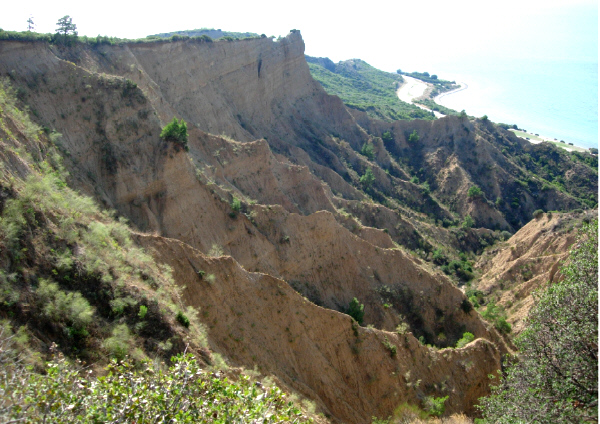
View from Walker's Ridge. This was close to the left glank of the Anzacs in the early campaign. Below can be seen Anzac Cove, and behind the photographer is the Nek, locale of the battle depicted in the film Gallipoli.
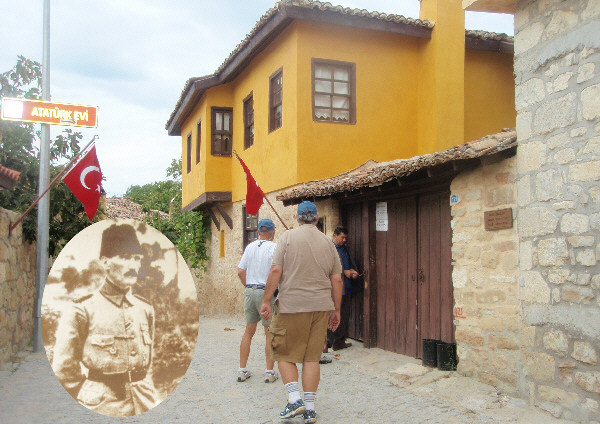
This yellow house in the village of Bigali was Mustafa Kemal's headquarters during the Gallipoli campaign. There are numerous monuments and informational displays (like the insert) across the Gallipoli Peninsula and at Çanakkale extolling his contributions.
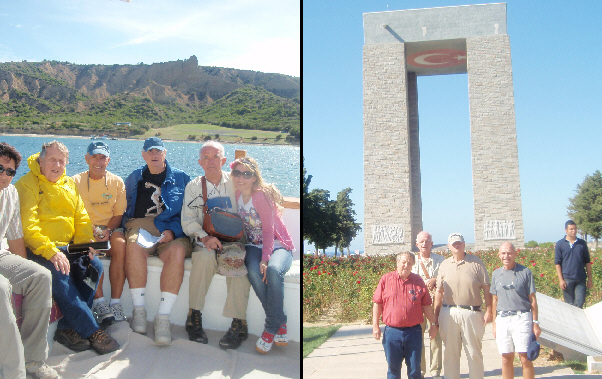
Two group shots: off of North Beach-Anzac (L) and at the Turkish Memorial, Cape Helles (R). On the Anzac photo, the "Sphinx" is conspicuous: Our excellent guide Koray Çirik is on the left and Flo-Turkey public relations Rep and executive trainee Sibel Gezer is the Lady in Pink. Sibel was a hit with the troops. David, Fred, Myself and Mike are at the memorial on the right side image.
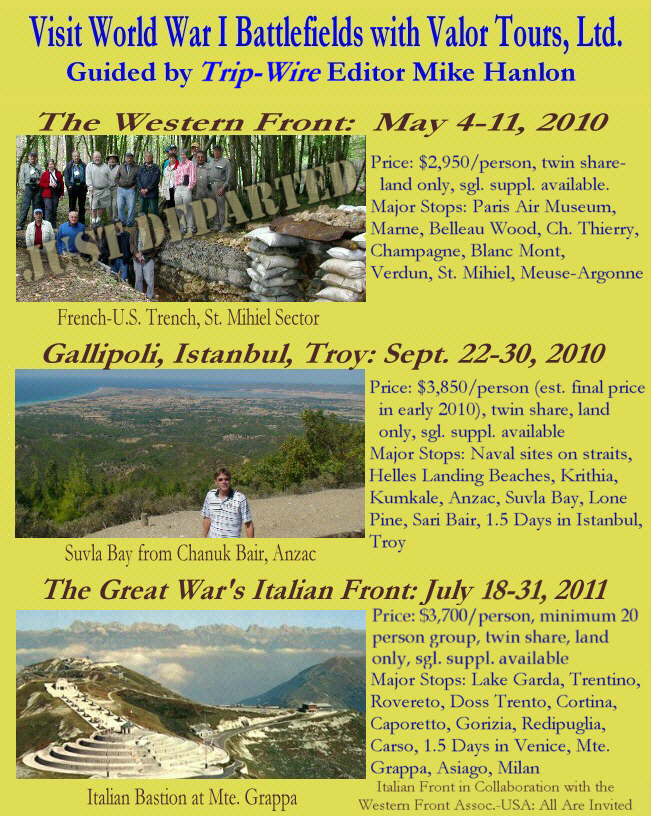
(Click on image or email Mike Hanlon at greatwar@earthlink.net to request a brochure for Western Front tour or more details on the other trips)
|
|

How France Viewed the Armistice
|

Germany is finally seeing things clearly
from the French publication Grand Ecrivains
|
Click Here to Visit the Website of Our Contributing Editor Tony Langley
War in a Different Light
|
The Russian Front:
A Brief Look at the Imperial Air Service
Raul Colon
The war between the Central powers, mostly Imperial Germany and Tsarist Russia lasted three hard-fought years. It ended abruptly on October 1917 when the Bolsheviks seized power in Moscow. When the Great War started on August 1914, Germany and Russia shared a vast frontier that stretched from the midway between Danzig and Riga, near the Baltic coast, running west of Warsaw, south through Galicia, finally ending on the mouth of the Danube on the Black Sea. The first phase of the air action took place in two main sectors of the border: the northern area and Galicia. Initially, German air assets in the east were limited. Nevertheless, this token force would have been enough to annihilate the disarticulated Russian air force.
In 1914 the strength of the infant Imperial Russian Air Service consisted of 244 airplanes, 12 airships and 44 observation balloons. Of the 244 planes, 145 were operational and deployed near the combat theater. Most of them were French-designed and built under license by Russian manufacturers such as Duks and the Russo-Baltic Wago Works. During the months prior to the war, the Imperial Flying Corps received most of its assets from France. Aircraft such as the Farman MF-IIs, Morane-Saulniers, Nieuport 11s, Nieuport 17s and Spad VIIIs found their way the Corps ranks.

Russia's Most Famous Aircraft of WWI: The Ilya Muromets
Russian manufacturers did build indigenous flying machines such as the Anata DS and Lebed. But both were inferior copies of foreign designs, and because of it they never saw extended action. The only, Russian-designed air platform to see action during the first year of the war was the massive Sikorsky four-engine bomber. Seventy three of the Ilya Muromets G-9 heavy bombers were constructed from 1914 until 1917.
The G-9 began offensive operations on February 1915. As was the case on the Western Front, early air combat tactics in the east were primitive and unimaginative. Still, the Russian high command placed much of its war strategy in the air service's ability to disrupt the vaunted German railroad access system near its border. But that was never the case. By 1915, the combined strength of Germany and Austria-Hungary managed to push back large Russian army formations without much harassment from the skies.
As the Russian army retreaded to the Ukraine, its air service began mount, for the first time in the conflict, combined offensive operations. From the Lutsk and Kovel regions, young Russian pilots took to the air in an effort to engage German troop columns moving deeper inside their homeland. As their territory was savaged and invaded, more and more Russians joined the armed forces, most of them went into the air force.
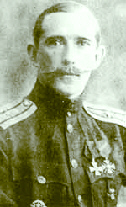
Major Kazakov |
One particular airman distinguished himself on the cold Eastern Front, his name was Aleksandr Kazakov. Kazakov was born in the Kherson province. After attending the prestigious Yelizavetgrad Cavalry School in 1908, Kazakov joined the Gatchina military aviation school, completing his training by 1914. In 1915 Aleksandr was sent to the Ukraine with the purpose of shoring up air operations in the region. It was there that his reputation as a top ace was formed. Flying Morane-Saulnier, Spad-SA2, Nieuport 11 and Nieuport 17 planes, the young airman is credited with shooting down 17 Central powers aircraft, top among Russian pilots at the time. There was a rumor that the number is actually 32, but because the Russian counted only aircraft which crashed on its territory, seventeen is the figure recorded in the history books. In 1917 he was assigned command of the newly formed No. 1 Fighter Group, but the unit was disbanded when the Bolshevik took control in October. Later, Kazakov made his way north to Archangelsk to join in with the British, who landed there in 1918. He perished in August 1st, 1919, while practicing aerobatics for the Russian White Army. Overall, 18 medals, including the British Distinguished Service Order and the French Legion d'Honneur, were awarded to this aviation pioneer.
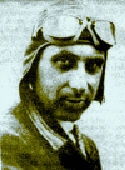
Seversky after the War |
Another trailblazing Russian pilot was Alexander de Seversky. As with fellow inventor Igor Sikorsky, Seversky's path will ultimately lead him to America. But not before he made an invaluable contribution to the Russian war effort. Stationed in the Gulf of Riga, Seversky, a naval aviator with the rudimentary Russian Naval Air Service, performed his first combat sortie, a solo attack against a German destroyer. While diving for his bomb run, he was shot down by antiaircraft fire only seconds before he was set to drop his bomb. As the plane crashed, the bomb exploded on contact with the sea, killing his spotter and blowing off his right leg. After healing, he returned to active duty and was assigned the mission of coordinating all fighter aviation units in the Baltic sector. Seversky is cited with 13 kills, but, as with many of the records of the era, this fact is disputed. He was in America when the revolution started. Shortly after which he applied for full citizen status. In the spring of 1922 he founded the Seversky Aero Corporation.
The fact the many Russian pilots became World War I aces, despite flying obsolete platforms and applying dreadful tactics, were a tribute to their skill and training. In general, the bulk of the Russian Air Service assets, although lagging almost a year behind in technology, still were good enough to hang in with the experienced German and Austrian pilots. The weakling was the command structure. The officer corps was filled with Tsarist-created nobility. A sense of entitlement permeated its core. Because of it, when disasters in the front mounted, they were ill equipped to handle. As was the case with much of the armed forces, they simply collapsed in the face of attrition.
It was the collapse of discipline all along the front, particularly in the Ukraine, in the aftermath of the revolution that inspired a counter political and military movement. Despite explicit order from the new Soviet regime, many Russian air force personnel continued to resist the Germans. One of them, Lieutenant Commander Viktor Utgov, of the Black Sea Fleet who, flying his Grigorovich M-9 seaplane out of the seaplane tender Imperator Nikolai Pervyi, attacked a German U-boat. After the war, Utgov joined the large cradle of Russian pilots immigrating to the United States.
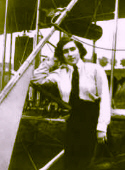
Princess Shakhovskaya |
Beside the Eastern Front, Imperial airmen found their way to the Western Front where they participated actively with the British Royal Flying Corps. Some British and a great number of French airmen fought with the Russians in the east. In a footnote of history, one of the first women to see combat action was Princess Eugine Shakhovskaya. She flew reconnaissance missions in the Riga region.
Sources:
An earlier version of this article appeared at the Aviationearth.com Website.
Way of a Fighter, Claire Chennault, Putnam Books 1949
The First World War, Hew Strachan, Penguin Books 2003
The Encyclopedia of Military Aircraft, Robert Jackson, Parragon Publishing Books 2006
|
|
|
Subscribe to Our Online Magazine
|
|

|
|
|
Page Three
|
|
|
Honoring America's Last Surviving Doughboy
Frank Buckles |

On September 11, 2009, as a preliminary to the TGWS/WFA-USA seminar at the National World War I Museum, the Great War Society dedicated a brick on the walk of honor at the Museum to Mr. Frank Buckles, currently residing in Charles Town, West Virginia. He is shown on the left arriving in England in 1918. Mr. Buckles was unable to travel to the event, but a strong contingent (on the right of the photo) from Bethany, Missouri, represented him.
An audience of about 50 witnessed the dedication. Trip-Wire editor Mike Hanlon moderated the event, which included comments from Dana Lombardy, President of the Great War Society, Eli Paul, Director of the National World War I Museum, and Jeffrey Aarnio, Representing Senator Max Cleland, Secretary of the American Battle Monuments Commission, as well as a poetry reading by Mr. Buckles's grandniece, Marisa Daniel. Afterwards, the Buckles family was given a special tour of the museum by Docent Mary Fry. The essential help of George Thompson of the WFA-USA and the staff of the National World War I in organizing this event is greatly appreciated.
|
|
World War I Headlines
in the
21st Century
|
|
 |
Raki with Norman
Editor Mike Hanlon Gets to Chat with Noted Author Norman Stone
at an Istanbul Street Cafe
|

Norman Stone |
One of the punishments for being a magazine and Website editor is that you get a lot of review copies of new titles from publishers. As I was in the last stages of preparation for my recent trip to Gallipoli, I received a copy of Norman Stone's concise new history titled World War One from Basic Books, its American publisher. I found it a terrific little work (not much in the military history field has so frequently surprised me or made me smile) and want to strongly recommend it to you. Reading some of the accompanying biographical information, I learned that the author is now teaching at universities in Ankara and Istanbul. An email exchange with the publisher's marketing staff yielded his email address, and the professor and I were soon corresponding. It turned out that this academic year, he is at Bilkent University in Ankara, but he would be visiting Istanbul for a brief post-Ramadan holiday while I was passing through. We could meet for a drink and talk about his book. There were some complications, but on the evening of my first full day in Istanbul I found myself in a yellow cab heading for a rendezvous with one of the most acclaimed of all World War I authors at the bar of his elegant 19th-century hotel, the Grand London. (Its owner later bragged to me that it is used as a set in a lot of films made locally.)
As we were getting acquainted, our discussions focused mostly on his new work and how pleased Norman and his publisher are about its reception. The manuscript was originally produced for a small publisher as part of a series, but that party got cold feet over the marketability of a WWI title. When mega-publisher Penguin Books heard about it, however, they jumped on it, guaranteeing a larger production run, international distribution, much more visibility on its release, and a much, much more lucrative deal for the author. Needless to say, after outstanding reviews and excellent initial sales, a large second run is being planned. We spent some more time covering the single major criticism of World War One that has surfaced: Norman's assertion that the July Crisis of 1914 was not a case study in mutually reinforcing diplomatic blunders as it's usually depicted, but a series of manipulations by a German government exploiting the Archduke's assassination to initiate a war they desired to fight before Russia got too strong for them. Norman told me that he's convinced Germany's intentions and strategy were fully revealed in the Treaty of Brest-Litovsk and that if they had won in the West something similar would have ensued there. After he explained this, I finally understood why he opened the work with the signing at Brest-Litovsk, which had puzzled me initially.
Norman then shared that he needed to get some food before his midnight departure for Ankara and invited me to join him for dinner. I had eaten already but was happy to tag along and accompanied him through some sort of time warp to a nearby alley that had a series of outdoor cafes strung out along its route. The crowd was international, the feel exotic. "This is as close as I'll ever get to the Casbah," I thought to myself. We worked our way to a crowded spot where he was recognized by a waiter and some of the other customers--obviously, Norman is a regular there--and suddenly another table and two chairs magically appeared. We sat. I was surprised to find myself lounging in the middle of a street, next to the owner of the Grand London, whom I had met earlier.
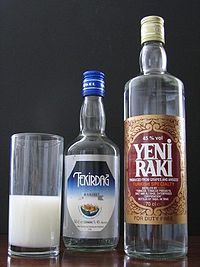
Raki Turns Milky
Mixed With Water |
Norman ordered dinner and drinks for himself and informed me that I needed to be introduced to the Turkish national drink, raki. Raki is a distilled beverage made from grapes and other fruits. It has a licorice taste and--I can now attest--packs a wallop. This would dramatically shift our interaction from balanced discussion to basically a one-sided--albeit highly, entertaining--monologue by Norman. Part of this was due to my residual jet lag, part to the impact of raki on myself, but the most import factor was raki's influence on my dinner companion. I haven't mentioned it yet, but Norman is a Scotsman. In our initial chatting this was hardly a communications issue. As the raki flowed, however, Norman's Scottish brogue became more and more pronounced, and a point was reached after an hour or so, where I could no longer understand a single word he was saying. He diagnosed my reduced responsiveness as my being exhausted from my 8,000-mile journey and very kindly packed me in a cab, paid the driver himself, and sent me safely back to my own hotel. I do remember a few things, though, and I would like to share them with the readers. (Don't forget the effect of raki, however.)
We discovered that we have a mutual friend. When he was writing his masterwork, The Eastern Front, Norman visited the Hoover Institution at Stanford University. Just as I did, he found it daunting to navigate between the library collection and the archives section. And just as I was, he was rescued by a gentle little lady named Agnes Peterson, Curator of the European Collection at the Hoover. Agnes was also the person who steered me to The Great War Society and, I guess, is ultimately responsible for this newsletter that you are now reading. I had to tell Norman that our friend had died recently. Of course, we raised a toast to her memory.
Norman gave me some advice about visiting the Gallipoli sites. I told him that I thought the greatest opportunity for success by the Allies, the Suvla Bay operation in August, was "blown" by incompetent generalship. He responded that the greatest limitation on the Allies at Helles, Anzac, or Suvla was in providing water for the advancing troops. At Suvla this factor weighed heavily on the British commander, Lt. General Stopford. The following days visiting the battlefields, I was always aware of how dry things were and that there were few sources of water on the Allied side.
Some of the best tales I heard that evening involved Norman's work as a speech writer for Margaret Thatcher and his preference for teaching Turkish students, who are receptive to learning new things, versus Oxford-Cambridge types, who come in preformed and unreceptive, if I heard things right.
I wished I remembered more from that evening because I had a really great time with Professor Stone. He autographed my copy of his book: "For Michael Hanlon, with many thanks for being so kind." Same to you, Norman. I'll remember our evening together every time I taste licorice for the rest of my life.
|
|
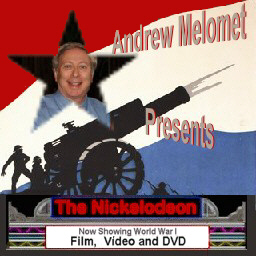 |
From the Archives --
J.R.R. Tolkien Documentaries
Reviewed by Andrew Melomet
|
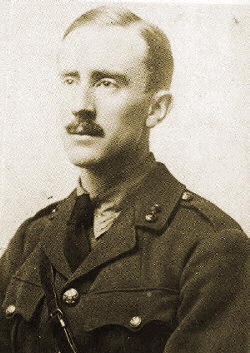
Lt. Tolkien in Uniform |
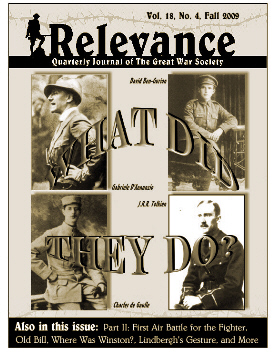
Tolkien's War Service is
Examined In-depth in the
Latest Issue of Relevance,
the Quarterly Journal of the
Great War Society. For
Information on Subscribing
(click here) |
In conjunction with the release of The Lord of The Rings trilogy of movies in the theaters and on DVD, several documentaries were released on DVD looking at J.R.R. Tolkien's life, his literary works and Great War service. Tolkien served as a signals officer in the Battle of the Somme in 1916, where two of his closest friends were killed. Eventually, trench fever sent him home for the rest of the war and quite possibly saved his life. The new documentaries include the National Geographic Video Beyond The Movie: The Lord of The Rings. Using footage from the movie, The Fellowship of The Ring, it takes an insightful and concise look at the themes of Tolkien's work, his hatred of industrialization and war; and his love of the English countryside, lovingly recreated in his works as The Shire, the home of the hobbits. The hobbits represent the best qualities of the English common folk that Tolkien had observed in the trenches and under fire.
Warner Home Video has released J.R.R. Tolkien: Master of The Rings, which focuses on the literary works, not on the movies. It features a fine selection of interviews and analysis by Tolkien experts including Aryk Nusbacher of Sandhurst Military Academy. Kultur has released a mammoth 4 DVD box set, Secrets of Middle-Earth: Inside Tolkien's The Lord of The Rings. It covers The Hobbit and The Lord of The Rings trilogy and features extensive use of archival interviews with Tolkien, his children Christopher and Priscilla, his publisher Raynor Unwin, and his first biographer Humphrey Carpenter. Bob Carruthers, author and military historian, is one of the best presenters and analysts in this DVD set. Running 240 minutes, there is some repetition between the DVDs, but this set does have the most footage of Tolkien reading his own works. The actual voice of the master adds a special quality to this set. Both the Warner and Kultur DVDs use computer-animated maps and landscapes and both feature the famous Middle-Earth illustrations of the Brothers Hildebrandt. The Warner release includes a CD of music by Rick Wakeman. Kultur's set includes musical performances by Mostly Autumn. It's a tough call which of these DVDs is the best, as each has its strengths and weaknesses. All I can say is, they're all a permanent part of my collection.
A recent documentary on the History Channel from the Clash of the Gods series includes an episode on "Tolkien's Monsters" that directly correlates Tolkien's experiences on the Western Front with his description of the ancient battle site of the "Dead Marshes." It is available at www.shop.history.com.
Click here to download the 2004-2008 Index for the Nickelodeon
with Updates on Availability of Films and Videos in the U.S.
Check the Archives for 2009's reviews.
|
|












